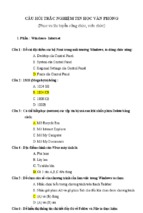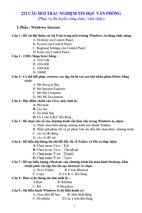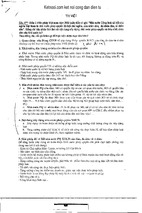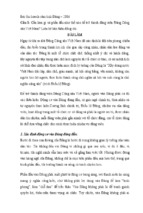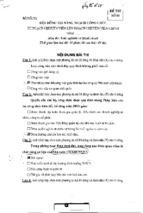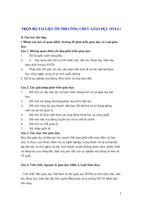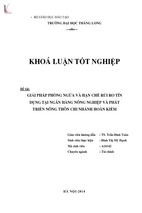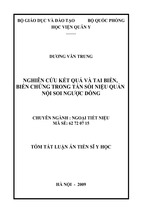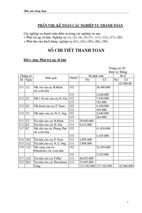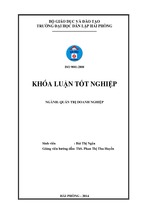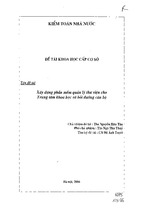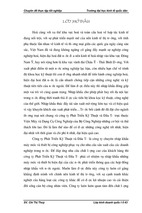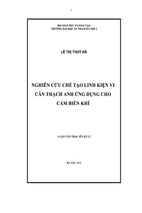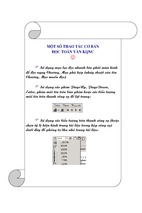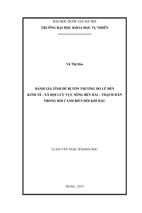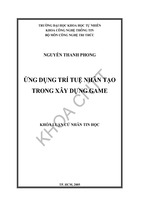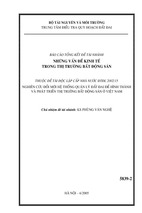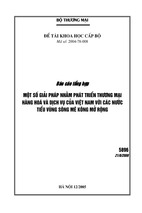LEVEL 1
2016
MIND MAPS
For learning CFA® Exam
WAY TO FINANCE SUCCESS - Website: http://waytofinancesuccess.com
All CFA Institute members and candidates are
required to comply with the Code and Standards
The CFA Institute Bylaws
Basic structure for enforcing
the Code and Standards
Based on two
primary principles
Rules of Procedure
Fair process to member and candidate
Confidentiality of proceedings
Maintains oversight and responsibility
The CFA Institute
Board of Governors
Professional Conduct
program (PCP)
Structure of the CFA
Institute Professional
Conduct Program
Is responsible for the
enforcement of the
Code and Standards
Through the Disciplinary
Review Committee (DRC)
The CFA Designated
Officer
Directs professional conduct staff
om
Written complaints
Evidence of misconduct
Report by a CFA exam proctor
.c
An inquiry can be prompted
by several circumstances
/
Selfdisclosure
Conducts professional
conduct inquiries
Analysis of exam materials and monitoring
of social media by CFA Insitute
ss
a.
ce
Requesting a written explanation
from the member or candidate
uc
The Professional
Conduct staff conducts
an investigation that
may include
es
Interviewing
The member or candidate
Complaining parties
Third parties
Issue a cautionary letter
If finding that a violation of
the Code and Standards
occurred, the Designated
Officer proposes a
disciplinary sanction
Upon reviewing the
material obtained during
the investigation, the
Designated Officer may
to
Process for the enforcement
of the Code and Standards
When an
inquiry is
initiated
Conclude the inquiry with no disciplinary sanction
fi
1. Code Of Ethics And
Standards Of
Professional Conduct
na
nc
Collecting documents and records in support of its investigation
/w
ay
Continue proceedings
to discipline the
member or candidate
Rejected by member
The matter is referred to a
hearing by a panel of CFA
Institute members
condemnation by the member's peers
If sanction is imposed
suspension of candidate's continued
participant in the CFA program
tp
:/
Accepted by member
ht
Act with integrity, competence, diligence,
respect and in an ethical manner
Integrity of investment profession &
interest of clients above personal interest
Six components of
the Code of Ethics
Care & judgment
Practice ethics & encourage others to practice
Integrity & viability of the global capital markets
Professional competence
b,c.
Professionalism
Integrity of Capital markets
Duties of Clients
Seven Standards of
Professional Conduct
Duties to Employers
Investment analysis, Recommendations & Actions
Conflict of interest
Responsibilities as a CFA Institute
member or CFA Candidate
1. Code Of Ethics And Standards Of Professional Conduct - CFA Mind Maps Level 1 - 2016 - Copyright by WAY TO FINANCE SUCCESS
WAY TO FINANCE SUCCESS - Website: http://waytofinancesuccess.com
Understand and comply with
applicable laws and regulations
Code and Standards vs. Local law
Follow stricter law and regulation
Responsible for violations in which they
knowingly participate or assist
Dissociate from illegal,
unethical activities
Guidance
Leave employers (in extreme case)
Attempt to stop the behavior by bringing it to the attention of
employer through a supervisor or compliance department
Participation or association
with violations by others
May consider directly confronting
the involved individuals
Intermediate steps
If not successful,--> step away and
dissociate from the activity by
Removing their name from written reports
Asking for a different assignment
Inaction with continued association may be construed as knowing participation
A. Knowledge
of the law
Not required reporting violations to government, CFAI,
but advisable in some cases or required by laws in others
Stay informed
Review procedures
Members and
candidates
Maintain current files
When in doubt, seek advice of
compliance personnel or legal counsel
When dissociating from violations, --> Document
any violations and urge firms to stop them
Recommended
procedures for
compliance (RPC)
Develop and/or adopt a code of ethics
Firms
Make available to employees info that
highlights applicable laws and regulations
Establish written procedures for reporting suspected
violation of laws, regulations or company policies
Application
Maintain independence and
objectivity in professional activities
By benefits
May try to pressure sellside analysts
om
From Buyside clients
e.g. to issue favorable research reports/
recommendations for certain companies
Internal
pressures
.c
From their
own firms
to issue favorable research on current or
prospective investmentbanking clients
Investmentbanking
relationships
ss
How to cope with external and
internal pressures
To issue favorable reports
From public companies
/
External
pressures
Gifts, Invitations to lavish
functions, Tickets, Favors, Job referrals,
Allocation of shares in oversubscribed IPOs...
Conflicts of interest
ce
Modest gifts and entertainment are
acceptable but special care must be taken
must disclose to employers
Best practice: reject any offer of gifts,
threatening independence and objectivity
uc
Guidance
-->
es
B. Independence
and objectivity
Recommendations must
convey true opinions
free of bias from pressures
be stated in clear
and unambiguous language
nc
Portfolio managers must respect and
foster honesty of sellside research
Is fraught with conflicts
Must engage in thorough,
independent, and unbiased analysis
fi
na
2.1 Standard I
PROFESSIONALISM
Must fully disclose potential conflicts,
including the nature of compensation
Issuerpaid research
Must strictly limit the type of compensation
they accept for conducting research
Analysts
to
Accept only flat fee for their
work prior to writing the report
ay
Best practice
Without regard to conclusions
or recommendations
Protect integrity of opinions
/w
Create a restricted list
Restrict special cost arrangements
:/
Limit gifts
RPC
Equity IPOs
Restrict employee investments
Private placements
tp
Review procedures
ht
Written policies on independence
and objectivity of research
Definition of
"Misrepresentation"
any untrue statement or omission of a fact
or any false or misleading statement
Must not knowingly make
misrepresentation or give
false impression in
oral representations, advertising
electronic communications
written materials
qualifications or credentials, services
performance record
Guidance
Must not misrepresent
any aspect of practice, including
Without regard to conclusions or
recommendations
characteristics of an investment
any misrepresentation relating to
member's professional activities
C. Misrepresentation
Must not guarantee clients specific return
on investments that are inherently volatile
Standard I(C) prohibits plagiarism in preparation
of material for distribution to employers, associates,
clients, prospects, general publish
Written list of available services, description of firm's qualification
Designate employees to speak on behalf of firm
RPC
Prepare summary of qualifications and experience,
list of services capable of performing
Maintain copies
To avoid plagiarism
Attribute quotations
Attribute summaries
Address conduct related to professional life
Any act involving lying, cheating, stealing, other dishonest conduct that
reflects adversely on member's professional activities would be violation
Guidance
D. Misconduct
Violations
Conduct damaging trustworthiness or competence (include behaviour may
not be illegal but negatively affect a member to perform responsibility such
as abusing alcohol during lunch hours)
Abuse of the CFA Institute Professional Conduct Program
Involved in personal bankruptcy is not automatically assumed to be in violation but
bankruptcy involve fraudulent or deceitful business conduct may be a violation
Develop and/or adopt a code of ethics
RPC
Disseminate to all employee a list of potential violations
Check references of potential employees
2.1 Standard I PROFESSIONALISM - CFA Mind Maps Level 1 - 2016 - Copyright by WAY TO FINANCE SUCCESS
WAY TO FINANCE SUCCESS - Website: http://waytofinancesuccess.com
a1. Why were the GIPS Standards created?
a2. Who can claim compliance?
Note: GIPS standards are printed in their
entirety in the readings, but the Level I
candidate is required only to know the
material through the end of Section II.0
"Fundamental of Compliance."
Fundamentals and Compliance
Consistency of input data is critical to
effective compliance with GIPS and
establish a foundation for full, fair and
comparable performance presentations
Uniformity in methods used to
calculate returns to achieve
comparability among firms
A composite must include all actual, fee-paying
discretionary portfolios managed in accordance
with the same investment objective or strategy
Introduction to Global
Investment Performance
Standards (GIPS)
/
ce
Real estate
Wrap Fee/ Separately Managed
Account (SMA) portfolios.
na
GIPS must be applied on the firm-wide basis. Firm must be defined as an investment
firm, subsidiary, or division held out to clients as a distinct business entity
tp
Investment firm definition
ht
or
After 5-year compliant history has been achieved, firms must
add an additional year of performance each year until
10-year performance record is established, at a minimum
Firm discloses non-compliance period
and explain how it is not in compliance
with GIPS
To claim GIPS, investment management
firms must define its "firm"
fi
:/
Firms from any country may come into compliance with GIPS
A firm may link non-GIPS
compliant performance to its
compliant history as long as
To promote fair competition among investment management firms
Require Firms to include all actual fee paying,
discretionary portfolios in composites defined
according to similar strategy/investment objectives
Rely on integrity of input data
Key characteristics
/w
If local/country specific law or
regulation conflicts with GIPS
To obtain global acceptance of calculation and presentation
standards in a fair, comparable format with full disclosure
To promote global "self regulation"
to
Make full disclosure of the conflict
How are GIPS standards
implemented in countries
with existing standards
for performance reporting
The scope of the GIPS
Historical performance record
A single verification report is issued for the entire firm.
Verification cannot be carried out for a single composite
Firms that have been verified are encouraged to add a disclosure to composite presentations or
advertisements stating they have been verified: "[name of firm] has been verified for the periods
[insert dates] by [name of verifier]. A copy of the verification report is available upon request."
GIPS Objectives
ay
Comply with local law or
regulation conflicts with GIPS
only GIPS compliant performance is
presented for periods after 1 Jan. 2000;
and
c. Verification
Firms are encouraged but not required
to undertake the verification process
To ensure consistence, accurate investment performance data
3+4 GIPS
A wrap fee portfolio is sometimes
referred to as a "separately managed
account (SMA) or "managed account"
minimum of 5 years,
less than 5 years.
Improve a firm's internal policies and procedures with
regard to all aspects of complying with the GIPS standards.
es
nc
is charged by a wrap fee sponsor for investment
management services and included trading
expenses that cannot be separately identified
Firms must initially show GIPS compliant history for a
since inception if the firm has been in existence for
Increase the level of confidence that a firm claiming
GIPS compliance did adhere to GIPS
uc
Private equity
Wrap fees are a type of bundle fee and are
specific to a particular investment product
Total firm assets must be the aggregate of the market value of
all discretionary and non-discretionary assets under management.
This includes both fee-paying and non-fee-paying assets
Terminated portfolios must be included in the
historical returns of appropriate composites
ss
Major sections of
GIPS standards
Composites must include new portfolios on a
timely and consistent basis after the portfolio
comes under management
Firms may set minimum asset levels for inclusion in
a portfolio, but changes to a composite-specific
minimum asset level are not permitted retroactively.
.c
Disclosures
Presentation and reporting
Note: this differs from Standards of
Professional Conduct in which the
stricter of local laws or Standards of
Professional Conduct prevails
b. Construction & purpose of Composites
om
Composite construction
No "negative assurance" is needed
for non-applicable disclosures
can be all-inclusive, asset-based fees and may include
a combination of investment management fees, trading
expenses, custody fees and/or administration fees
Prospect clients and investment
management firms
A composite is an aggregation of discretionary
portfolios into a single group that represents a
particular investment objectives or strategy
allow firms to elaborate on the raw
numbers and give the end user the
proper context to understand
Refers to investments in non-public
companies that are in various stages of
development and venture investing,
buyout investing and mezzanie financing
Only investment management firms
that actually manage assets
Input data
Calculation methodology
composite return is the
asset-weighted average of all the
portfolios' performance results
a3. Who benefit from Compliance?
The financial markets and
investment management industry
are becoming increasingly global
If an investment firm applies GIPS in a performance situation that is
not addressed specifically by GIPS/ is open to interpretation,
disclosures other than those required by GIPS may be necessary
GIPS do not address every aspect of performance
measurement, valuation, attribution or cover all asset classes
Key features of the
GIPS standards &
fundamentals of
compliance
Firms must meet full
compliance to claim GIPS
Effective date
Compliance cannot be achieved on a
single product, portfolio, or composite
The effective date of the revised Standards is 1 Jan 2011.
Presentations that include performance results for periods after 31
Dec. 2005 must meet all the requirements of the revised GIPS.
Performance presentations that include results through 31 Dec. 2005
maybe prepared in compliance with the 1999 version of GIPS.
Documents policies and procedures
Firms must document, in writing, their polices and
procedures used in establishing and maintaining
compliance with all requirements of GIPS
Once a firm has meet all the required requirements of GIPS , use this
statement to declare: "[Insert name of firm] has prepared and presented this
report in compliance with the Global Investment Performance Standards (GIPS)."
If not meet all the requirements, cannot state:"...in compliance with GIPS except for..."
Firms previously claiming compliance with an Investment Performance
Council-endorsed Country Version of GIPS are granted reciprocity to
claim compliance with GIPS for historical periods prior to 1 Jan. 2006
Claims of compliance
Statements referring to the calculation methodology used in a composite
presentation as being "in accordance [or compliance] with the Global
Investment Performance Standards" are prohibited .
Statements referring to the performance of a single, existing client as being "calculated in
accordance with the Global Investment Performance Standards" are prohibited except when a
GIPS complaint firm reports the performance of an individual account to the existing client
provide a compliant presentation to all prospect clients, cannot
choose to whom they want to present compliant performance
Firm fundamental
responsibilities
3+4 GIPS - CFA Mind Maps Level 1 - 2016 - Copyright by WAY TO FINANCE SUCCESS
provide a complete list and description of all of the firms'
composites to any client that makes such a request
must list discontinued composites on
the firms' list of composites for at
least 5 years after discontinuation
WAY TO FINANCE SUCCESS - Website: http://waytofinancesuccess.com
/
om
.c
ss
ce
ay
/w
ht
tp
:/
Click here
to
fi
na
nc
es
uc
To be continued…
For MORE CFA® Mind Maps, please go to
http://waytofinancesuccess.com
Wanna get Full Mind Maps for FREE ???
WAY TO FINANCE SUCCESS - Website: http://waytofinancesuccess.com
om
/
to solve many types of time
value of money problems
Find PMT
Loan payment
and Amortization
a. Interest rate,
considered as
.c
Find N
Find I/Y
Other applications
nc
Connection between
PV, FV & series of CF
The cash flow additivity principle refers to the fact that present value of any
stream of cash flows equals the sum of the present values of the cash flows
5. TIME VALUE
OF MONEY
b. Interest rate
Several risks of securities
FV of Annuity Due = FV of Ordinary
Annuity x (1+ I/Y)
e. CF calculations
Annuity
tp
PV of a Perpetuity
Use CF function in Calculator
Longer-term bonds have more risk
than shorter-term bonds
c,d. EAR
Non-annual time value of
money problems
divide the stated annual interest rate by the number of compounding
periods per year, m, and multiply the number of years by the number
of compounding periods per year
ht
Discount each individual cash flows
receiving less than fair value if an
investment must be sold for cash quickly
Where:
Periodic rate = stated annual rate/m
m
= the number of compounding periods per year
:/
/w
Annuity Due
a borrower will not make the promised
payments in timely manner
represents the annual rate of return actually being earned after
adjustments have been made for different compounding periods
ay
Ordinary Annuity
real risk-free rate is a theoretical
rate on a single-period loan when
there is no expectation of inflation.
-->The required rate of return on a security = real risk-free rate + expected inflation rate
+ default risk premium + liquidity premium + maturity risk premium
to
a series of equal cash flows that occurs
at evenly spaced intervals over time.
liquidity risk
maturity risk
fi
Present value
occur at the beginning of each time period.
default risk
na
Future value
PV of Annuity Due = PV of Ordinary
Annuity x (1+ I/Y)
Nominal risk-free rate = real risk-free rate
+ expected inflation rate
es
the sum of the present values of the cash Rows is the present value of the
series. The sum of the future values (at some future time = n) of a series of
cash flows is the future value of that series of cash flows.
occur at the end of each time period.
Opportunity cost
uc
Funding a future obligation
Discount rate
for calculating the present value of
future cash flows
ce
f1. Use time line
Rate of compound growth
Number of periods for specific growth
ss
Amortization table
Required rate of return
equilibrium interest rate for a
particular investment
Uneven CF
5. TIME VALUE OF MONEY - CFA Mind Maps Level 1 - 2016 - Copyright by WAY TO FINANCE SUCCESS
WAY TO FINANCE SUCCESS - Website: http://waytofinancesuccess.com
the PV of the cash flows less the initial (time = 0) outlay
where:
CFt = the expected net cash flow at time t
N = the estimated life of the investment
r = the discount rare (opportunity cosr of capital)
NPV
.c
om
/
Convert among these yields
Calculate,
Interpret,
Decision rule
Not much meaningful
es
6. DISCOUNTED
CASH FLOW
APPLICATIONS
BEY = 2 x
semi annual discount rate
Multiple IRR or No IRR
na
fi
Money market yield
ay
Bond equivalent yield
When CFA pattern is unconventional
IRR method: project cash flows are
assumed to reinvest at IRR while with NPV
it is assumed to reinvest at market rate
--> at the bottom lines: use NPV
Accept projects with an IRR > the firm's
(investor's) required rate of return.
Decision rules
Reject projects with an IRR < the firm's
(investor's) required rate of return.
For single project, IRR and NPV
lead to exactly the same decision
HPR
is the percentage change in an
investment over the period of holding
defined as the IRR
tp
rMM = HPY x (360/t)
ht
Effective annual yield
Differen timing of cash flows
Unrealistic assumptions
:/
/w
Holding period yield
Different project size: the smaller projects may have
higher IRR but their contribution to the firm value
may be smaller compared to the larger projects
IRR
nc
Bank discount yield
Yields of T-bills
Where:
Po = initial price of the the instrument
P1 = price received for instrument at maturity
D1 = interest payment (distribution)
Problems
to
Where:
r BD = the annualized yield on a bank discount basis
D = the dollar discount, which is equal to the difference
between the face value of the bill and the purchase price
F = the face value (par value) of the bill
t
= number of days remaining until maturity
360 = bank convention of number of days in a year
Two mutually exclusive projects:
accept higher positive NPV
Conflict with
NPV due to
uc
3. Use simple interest, ignore
reinvestment of interest
Reject projects with a negative NPV
is the discount rate that make the
NPV of a project equal to zero
ce
2. Use 360-day
Decision rules
ss
1. Based on face value, not price
Acce pt projects with a posi tive NPV
Money Weighted
More appropriate if manager has
complete control over cash in/out
measures compound growth
Not affected by cash in/out
Portfolio
rate of return
Preferred method
Time weighted
(chain-link)
Value the investment immediately after
any withdrawals or deposits, divide the
overall investment horizon into subperiods
3 steps
Calculate HPR for each subpediod
Compute the geometric mean
6. DISCOUNTED CASH FLOW APPLICATIONS - CFA Mind Maps Level 1 - 2016 - Copyright by WAY TO FINANCE SUCCESS
WAY TO FINANCE SUCCESS - Website: http://waytofinancesuccess.com
Statistics is used to refer to
data and to the methods we
use to analyze date
Descriptive statistics
Statistical methods
Inferential statistics
to summarized the important
characteristics of large data sets
pertain to the procedures used to
make forecasts, estimates, or
judgement about a large set of data
A population is defined as the set of all
possible members of a stated group
Population parameters
Sample statistics
a.
l. Kurtosis
Leptokurtic: more peaked, fatter tails
(excess kurtosis > 0) --> more risk
Mesokurtic: identical (excess kurtosis = 0)
Nominal scales
Compared with
normal distribution
Ordinal scales
/
Interval scales
Symmetrical
om
Ratio scales
mean=median=mode
ss
j,k. Shape of distribution
Definition
Frequency distribution
Limitations
Sharpe Ratio / Reward-to-Variability ratio
56%: +/-1.50k
75%: +/-2k
Population mean
Sample mean
h. Chebyshev's inequality
Arithmetic mean
:/
89%: +/-3k
line chart
/w
For any distribution with finite variance, the
percentage of observations lie within k standard
deviation of the mean is at least 1-1/(k^2)
36%: +/-1.25k
Frequency polygon
ay
Negative Sharpe ratio
Not suitable with asymmetric return distribution
94%: +/-4k
affected by extreme value
no info on how data is distributed
Range = Max - Min
Weighted mean
(portfolio return)
(compound growth)
(return data set)
e. Measures of
central tendency
less sophisticated than Var and Sd
Use of arithmetic or geometric mean
when determining investment returns
Harmonic mean
(cost of shares)
g. Dispersion
(measure of risk)
Population
the measure of central tendency
for which the sum of the deviations
from the mean is zero
Geometric mean
ht
better than range
Mean
tp
Easy to compute
3. Count the observations and then calculate
bar chart
Histogram
to
i. Relative dispersion
2. Tally the observations
summing the relative frequencies starting at the
lowest interval and progressing through the highest.
Cumulative relative frequency
d.
1. Define interval
3 steps
summing the absolute frequencies starting at the
lowest interval and progressing through the highest.
Cumulative absolute
frequency
na
fi
CV (Coefficient of Variation)
cannot build meaningful ratios
calculated by dividing the absolute
frequency of each return interval by
the total number of observations.
Relative frequency
7. Statistical Concepts
and Market Returns
No true zero point
Provide ranking, equal differences
between scale values and true zero point
Absolute frequency
c.
nc
Negatively skewed (Sk<0)
--> more risk
no information on the difference among categories
A tabular presentation of statistical data
that aids the analysis of large data sets
Construction of a
frequency distribution
ce
uc
Nonsymmetrical (Skewness)
(because of outliers)
es
Types
Specified characteristics are used to
categorize observations band involve ranking
A sample statistic is used to
measure a characteristic of a sample
Parameter vs. Sample statistic
b.
Classify or count observations with no
particular or ranking
A parameter is a measure used to
describe a characteristic of a population
.c
the frequency of experiencing
losses and gains are the same
Var (measures of variation around
center) which addresses risk
Like ordinal scales + the differences
between scale values are equal -> scale
values can be added and subtracted
Types of measurement scales
Positively skewed (Sk>0)
mean (measures of central tendency)
which addresses return
The most frequently concerned
Calculate
Excess kurtosis = sample kurtosis - 3
Platykurtic: less peaked (excess kurtosis < 0)
A sample is defined as a subset of
the populations of interest
Population vs. Sample
Harmonic < geometric < arithmetic
Variance & Standard deviation
value of middle item in a set of sorted items
Median
Sample
not affected by extreme value but
more difficult to find out
No mode
Semivariance and
semideviation
Mode
Unimodal, bimodal, trimodal
--> the only measure can be
used with nominal scale
Model interval -->
for continuous distribution
value at or below which a portion of the data distribution lies
Quartiles
f. Quantile
Quintile
Decile
into quarters
into fifths
into tenths
Percentile (100)
7. Statistical Concepts and Market Rerurns - CFA Mind Maps Level 1 - 2016 - Copyright by WAY TO FINANCE SUCCESS
Ly =(n+1) x y /100
WAY TO FINANCE SUCCESS - Website: http://waytofinancesuccess.com
/
om
.c
ss
ce
uc
ay
/w
ht
tp
:/
Click here
to
fi
na
nc
es
To be continued…
For MORE CFA® Mind Maps, please go to
http://waytofinancesuccess.com
Wanna get Full Mind Maps for FREE ???
WAY TO FINANCE SUCCESS - Website: http://waytofinancesuccess.com
Financial Statement
Additional disclosures required by regulatory
Element
Any commentary by management
FR
Financial position
Role of FR
Roles of FR & FSA
Useful to a wide range of users in
making economic decisions
Firm's performance
Changes in financial position
> To evaluate past, current, and prospective
performance & fin position
> To make economic decisions
Use info in a company's Fin Statements
Roles of FSA
Use other relevant info
Revenues
Income Statement
Expenses
Gains and Losses
Assets
Liabilities
Balance Sheet (A=L+OE)
Role of key FS
Owners' equity
CFO
CF statement
CFI
CFF
Statement of changes in Owners' equity
disclose the basis of preparation for FS
(e.g: accounting methods, assumptions,...)
/
acquisitions or disposals
om
legal actions
employee benefit plans
FS notes (footnotes)
.c
contingencies and commitments
Additional items:
significant customers
ss
sales to related parties
segments of firm
ce
are audited
operating income or sales by region
or business segments
Supplementary schedules
es
reserves for an oil and gas company
uc
not audited
info about hedging activities and
financial instruments
Importance of
nc
assessment of financial performance and condition of a
company from the perspective of its management
22. FSA
Introduction
na
Results from operations, with trends
in sales and expenses
Capital resources and liquidity, with trends in CF
fi
Publicly held companies in US
General business overview
discuss significant effects of trends, events, uncertainties
liquidity and capital resource issues, transactions
or events with liquidity implications
ay
MD&A
to
discuss accounting policies that require
significant judgements by management
/w
Discontinued operations, extraordinary
items, unusual or infrequent events
:/
Extensive disclosures in interim financial statements
tp
disclosure of a segment's need for CF
or its contribution to revenues or profit
= independent review of an entity's FS
ht
objective: auditor's opinion on fairness
and reliability of FS, "no material errors"
Independent review though FS prepared by mgmt and are its responsibility
3 parts
Reasonable assurance of no material errors (follow generally accepted auditing standards)
FS prepared in accordance with accepted accounting principles, reasonable accounting principles and estimates, consistency
Explanatory paragraph: when a material loss is probable but
amount cannot be reasonably estimated. Uncertainties
may relate to the going concern assumption --> signal serious
problems and need close examination by analyst
Audits of FS
Standard auditor's opinion
(under US GAAP): Opinion on internal controls
Unqualified opinion: auditor believes statements are free from material omissions and errors
3 types of Opinions
Qualified opinion: if statements make any exceptions to accounting principles --> explain these exceptions
Adverse opinion: if statements are not presented fairly or are materially nonconforming with accounting standards
Quarterly or semi- reports (NOT audited)
Interim reports
About election of board members, compensation, management and qualifications
and issuance of stock options
Other info sources
Proxy statements
Filed with SEC
Corporate reports and press releases
Viewed as PR or sales materials
1. Articulate the Purpose & Context of analysis
2. Collect data
FSA framework
3. Process data
4. Analyze/interpret data
5. Report the conclusions or recommendations
6. Update the analysis
22. FSA Introduction - CFA Mind Maps Level 1 - 2016 - Copyright by WAY TO FINANCE SUCCESS
WAY TO FINANCE SUCCESS - Website: http://waytofinancesuccess.com
Operating activity: activities that are part of the day-to-day business function of an entity
Classification
Investing activity: activities associated with acquisition & disposal of long-term asset
Financing activity: activities related to obtaining or repaying capital from shareholders or creditors
Assets
Liabilities
Equity
Elements
/
Revenue
FS elements
& accounts
.c
Chart of accounts : set forth the actual accounts used in a company's accounting system
Accounts
Contra account: offset or deducted from other accounts
ss
Account & financial
statement
om
Expense
Assets
Owners' equity
uc
Accounting equation
Contributed capital
ce
Liabilities
Retained earning
nc
es
Expanding: A = L + Contributed capital + BGN Retained earnings + Rev - Exp - Dividend
23. Financial reporting
mechanics
Unearned (Deffered) revenue
Cash movement after Acct. recognition
to
Accruals
fi
Accruals & Valuation
adjustment
na
Cash movement prior to Acct. recognition
Prepaid expense
Unbilled (Accrued) revenue
(when billing, Un.Rev decrease & Receivables increase)
Accrued expense
Relationships among IS,
BS and statement of CFs,
and of owners' equity
/w
BS: show a company's financial position at a point in time
tp
:/
Changes in BS accounts during an accounting period are
reflected in IS, statement of CFs and owners' equity
ht
Accounting system
Historical cost)
ay
Valuation adjustment: made to company's A or L so that account records current market value (not
1. Journal entries & Adjusting entries (record=time)
2. General ledger & T-accounts
Flow of information
3. Trial balance
(record=order)
(list account balances at a particular point in time)
4. Fin. statement
Debit & Credit
Using fin. statement
in security analysis
23. Financial reporting mechanics - CFA Mind Maps Level 1 - 2016 - Copyright by WAY TO FINANCE SUCCESS
Analyst uses FS to judge the fin. health of the company
Analyst can use his understanding to detect misrepresentation
WAY TO FINANCE SUCCESS - Website: http://waytofinancesuccess.com
Objective of FR: provide fin. info about the reporting entity
Overview FRS
Importance of reporting standards in security analysis and valuation
Standard-setting bodies
(establishing standards)
IASB (International Accounting Standards Board)
US FASB (Financial Accounting Standards Board)
IOSCO (international):
Standard setting &
Regulatory bodies
not a regulatory, but its members regulate significant portion
FSA (in UK)
Regulatory authorities
(enforcing standards)
1. Protect investors
SEC (in USA)
2. Ensure: market is fair, efficient, transparent
3. Reduce systematic risk
Status of global convergence of accounting standards
c.
standard setting bodies
disagree
Barriers to developing one universally accepted set of financial reporting standards
regulatory authorities
political pressures from business groups and others
Understandability
Verifiability
Relevance
Qualitative
characteristics
Enhancing
Faithful presentation
Trade off across Enhancing characteristics
(consistent among firms and time periods)
(reliability and relevance: timely)
Cost
Non-quantifiable info: omitted
of Financial position: A, L, E
Measurements
Assumptions
/
of performance: Income, Expense
Accrual basis
Going concern
Cost can be reliable measured
om
IFRS framework
.c
Constraints
Comparability
Timeliness
(complete, neutral, free from error)
Recognition principal
Probably future economic benefit will flow to entity
ss
Elements of FS
Historical cost : amount originally paid for the asset
ce
Current cost : would have to pay today for the same asset
Realizable value: amount for which firm could sell the asset
Measurement bases
uc
Present value : discounted future cash flows
es
Fair value : 2 parties in an arm's length transaction would exchange the asset
BS, IS, CFS, OE, Explanatory notes (inclu. accounting policies)
nc
Required financial statements
na
24. Financial
Reporting Standards
Aggregation
to
Principles for PREPARING
Consistency
ay
Comparative information
/w
Frequency of reporting
IASB requires mgmt to consider the
framework if no explicit standard exists
:/
tp
ht
No offsetting
Materiality
Purpose of framework
IASB same objective
Objectives of financial statements
Assumptions
Going concern basis
Accrual basis
fi
General requirements
for FS under IFRS
Fair presentation
FASB different objectives for biz and non-biz
IASB emphasizes going concern
FASB: relevance, reliability
Primary characteristics
IASB: comparability, understandability also
Qualitative characteristics
IFRS (by IASB) #
US GAAP (by FASB)
IASB: income+expenses
Performance
FASB: Revenues, Expenses, Gains,
Losses, comprehensive income
Asset definition
Financial statement elements
"Probable"
IASB: resource from which future
economic benefit is expected
FASB: future economic benefit
IASB: define criteria for recognition
FASB: define assets and liabilities
Values of assets to be
adjusted upward
IASB: allow
FASB: not allow
Transparency
Characteristics of a coherent
financial reporting framework
Comprehensiveness
Consistency
Valuation
Principles-based
Effective FR
Barriers to creating a coherent
financial reporting framework
Standard setting
Rules-based
IFRS
relies on broad framework
FASB in the past
specific guidance how to classify trx
Objectives oriented
FASB moving now
blend the other two
Measurement
24. Financial Reporting Standards - CFA Mind Maps Level 1 - 2016 - Copyright by WAY TO FINANCE SUCCESS
WAY TO FINANCE SUCCESS - Website: http://waytofinancesuccess.com
/
om
.c
ss
ce
uc
/w
ht
tp
:/
Click here
ay
to
fi
na
nc
es
To be continued…
For MORE CFA® Mind Maps, please go to
http://waytofinancesuccess.com
Wanna get Full Mind Maps for FREE ???
WAY TO FINANCE SUCCESS - Website: http://waytofinancesuccess.com
Saving
Borrowing
Issuing equity
Allow entities to
Main functions
of financial system
Risk management
Exchanging assets
Utilizing information
Equilibrium interest rate
Determine the returns that equate D &S
Allocate capital to most efficient uses
F.A: securities, currencies...
Financial A vs. Real A
Protect unsophisticated investors
R.A: commodities, real estate...
Establish minimum standard of competency
Public sec: trade on exchanges
Help investors evaluate performance
Objectives of
market regulation
Prevent insider
Public vs. Private securities
Classification: Assets & Market
(P reflects fundamental info)
Allocational efficiency
(at the best efficiency)
Trades occur at specific times
All bids+asks are declared, and then one negotiated price is set for the stock
used
Distinguish
Trade occur any time the market is open
dealer bid-ask quote
Price is set by
Classification
of markets
Continuous market
nc
auction process
45. Market Organization
& Structure
3. Time precedence
Matching rules
Order-driven markets
Distinguish
Primary market
Fixed income
Forward, Futures, Swap, Option
Contracts
Insurance
Credit default swap
Commodities
Real assets
Brokers
/w
Secondary market
M.O: execute at the best P
Block brokers
tp
ht
Order
Good-on-close
Good-on-open
Stop-sell
Exchanges
Alternative trading systems (ATS)
Good-til-cancelled
Immediate-or-cancel
help large trades
Investment banks
Brokers,Dealers & Exchanges
Market vs. Limit order
L.O
Stop-buy
Convertible debt=F.I+Equity
Currencies
:/
Importance: provide Liquidity+Price info
Hedge funds
Primary vs.
Secondary markets
Securities trade after initial offerings
sometimes refer as Depositories
ABS
ay
IPO vs. Secondary issues
ETFs and ETNs
Pooled investment vehicles
Asset classes
to
Brokered markets
Public offerings vs. Private placements
Securities
fi
1. Price
2. Display precedence
Mutual funds
na
Quote-driven markets (trade with dealers)
Preferred stock
Warrants
es
to set opening prices and prices after
trading halts on major exchanges
Capital: for equity+debt securities> 1y
Common stock
Equity
uc
Call market
in smaller markets
Secondary: subsequents sales of sec
Money: for debt securities < 1y
Money vs. Capital market
ce
Informational efficiency
Characteristics of
well-functioning fin. system
(Low cost)
Primary vs. Secondary market
ss
Operational efficiency
Der contract: values depend on the values of other assets
Primary: for newly issued sec
.c
(Availability)
Equity
Debt vs. Equity vs. Derivative
om
Require minimum level of capital
Complete market
Debt
/
Promote commom FR requirements
Private sec: not trade on exchange
Financial
intermediaries
Dealers
earn profit fr. bid-ask spread
Securitizers
Depository institutions
Validity
Insurance companies
Stop order
Arbitrageurs
refer who buy A in 1 market & resell in another market
Clearinghouses: intermediaries between buyers & sellers
Clearinghouses & Custodians
Custodians
Long =Buy
Long vs. Short
Short sales
Short =Sell
borrow securities & sell
Positions
borrow funds to buy A
Leveraged positions
45. Market Organization & Structure - CFA Mind Maps Level 1 - 2016 - Copyright by WAY TO FINANCE SUCCESS
Margin call P=P0
1 Initial margin
1 Maintenance margin
WAY TO FINANCE SUCCESS - Website: http://waytofinancesuccess.com
used to present the performance of an asset
class, security market or segment of a market
Security
market index
Price index: calculate price only
Calculate an index
Return index: include P+Income
Which target market?
Which securities?
Index construction
& management
How weight?
Re-balancing frequency?
Re-examining when?
= Sum of stock prices / Number of stocks adjusted for splits
om
Adv: simple
Adv & Disad
Adjust for stock split
/
Price-weighted index
.c
Disad: % change in a high-priced stock will have a greater
effect on the index
ss
Equivalent to a portfolio that has equal dollar
amounts invested in each index stock
ce
Equal-weighted index
NOT adjust
uc
Weighting methods
Weights based on the market-cap of each index stock
Market-cap weighted index
es
.
Criticism: large company has greater impact
nc
Float-adjusted market cap- weighted index
46. Security
Market Indices
na
Market float : (-) shares from Controlling shareholders
Free float: Market float - Not available to foreign investors
to
fi
Fundamental weighting
(earnings, dividends, cash flow)
Rebalancing &
Reconstitution
uses for Equal-weighted index
ay
Rebalance: adjust the weights of securities
/w
Reconstitution: add & delete securities that make up an index
Reflect market sentiment
Proxy for measuring of market return & risk
:/
ht
tp
Uses of securities
market indices
Types of equity indices
Proxy of beta & risk-adjusted return
Benchmark of management performance
Model portfolio for index fund
Broad market equity
Multi-market vs. Multi-market with fundamental weghting
Sector index
Market-cap
Style index
Types of Fixed Income indices
Value/Growth
Large universe
Dealer market & infrequent trading
Commodities index
Alternative investment indices
Hedge fund index
Illiquidity, transactions costs, high turnover of
constituent securities => Difficult & expensive
to replicate F.I index
based on future contract
may have upward-bias
Real estate index
46. Security Market Indices - CFA Mind Maps Level 1 - 2016 - Copyright by WAY TO FINANCE SUCCESS
WAY TO FINANCE SUCCESS - Website: http://waytofinancesuccess.com
Its return is based on another
instrument (underlying assets)
Physical
Definition
/
Underlying assets
om
NO arbitrage opportunities exist
.c
Arbitrage
Arbitrage & the law of one price
Daily settlement
uc
private between 2 parties -> illiquid
OTC
es
57. Derivative
Markets and
Instruments
Legal gambling
Firm and binding agreement -> obligation
Characteristics
fi
Risk management
Market efficiency
Forward commitment
Forwards
Futures
Options
Types of derivatives
Swaps
Premium is paid up front by the long
Exchange, OTC, Forward commitment
Exchange, Forward commitment
Exchange, OTC, Contingent Claims
OTC, Forward commitments
ht
a contract that provides a bondholder
(lender) with protection against a
downgrade or a default by the borrower
Credit derivatives
57. Overview of derivatives - CFA Mind Maps Level 1 - 2016 - Copyright by WAY TO FINANCE SUCCESS
No premium paid up front
The long has the flexibility -> options
Contingent claims
ay
Purposes of derivatives market
Trading efficiency
default risk & legal risk
at the end of the contract: settlement
to
Price discovery
tp
Low tnx cost
No default risk
Customized terms
/w
Mispriced -> adjust quickly ->
market efficiency
Criticism
:/
Control risk
Complex
na
Zero-sum game
Exchange
nc
Difficult to understand
Standard terms
Where derivatives are traded?
The law of one price
Information about underlying price
Organized market -> liquid
ce
-> Riskless profit without investment
The biggest trading volume
Event
ss
Buy an asset at one price
Concurrently sell it at higher price
Finance
Types
Credit default swap (CDS) -> most common
Credit spread option
WAY TO FINANCE SUCCESS - Website: http://waytofinancesuccess.com
= Long stock + short call
=
S
C
Covered call = call is covered by a long stock
om
/
Covered call
.c
Payoff diagram
ce
ss
Payoff (covered call) = Payoff (Long stock) + Payoff (short call)
= ST
- Max(0, S T - X)
uc
Profit (Covered call) = Payoff (Covered call) - So + C
Max loss when payoff is min -> S
T
= 0 -> Max loss = So - C
es
Max profit when payoff is max -> ST > X
Payoff diagram (Covered call): similar to payoff diagram of short put
na
nc
59. Risk Management
Applications of
Option Strategies
Protective put = Long put protects potential loss of a stock
ht
tp
:/
/w
ay
to
fi
= Long stock + Long put
=
S
+ P
Protective put
Payoff diagram
Payoff (Protective put) = payoff (Long stock) + Payoff (long put)
=
ST
+ Max(0, X - S T)
Profit = Payoff - So - P
Max loss when payoff is min -> S
T
= 0 -> Max loss = So + P - X
Max profit when payoff is max -> ST > X -> Max profit is indefinite
Payoff diagram (protective put) is similar to that of long call
59. Risk management Appications of Option Strategies - CFA Mind Maps Level 1 - 2016 - Copyright by WAY TO FINANCE SUCCESS
WAY TO FINANCE SUCCESS - Website: http://waytofinancesuccess.com
/
om
.c
ss
ce
uc
es
/w
ht
tp
:/
Click here
ay
to
fi
na
nc
To be continued…
For MORE CFA® Mind Maps, please go to
http://waytofinancesuccess.com
Wanna get Full Mind Maps for FREE ???
WAY TO FINANCE SUCCESS - Website: http://waytofinancesuccess.com
- Xem thêm -

